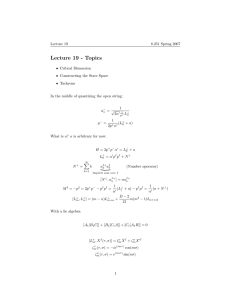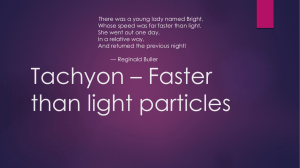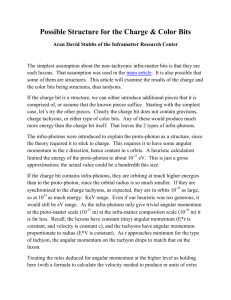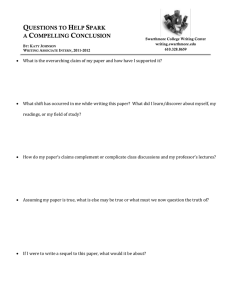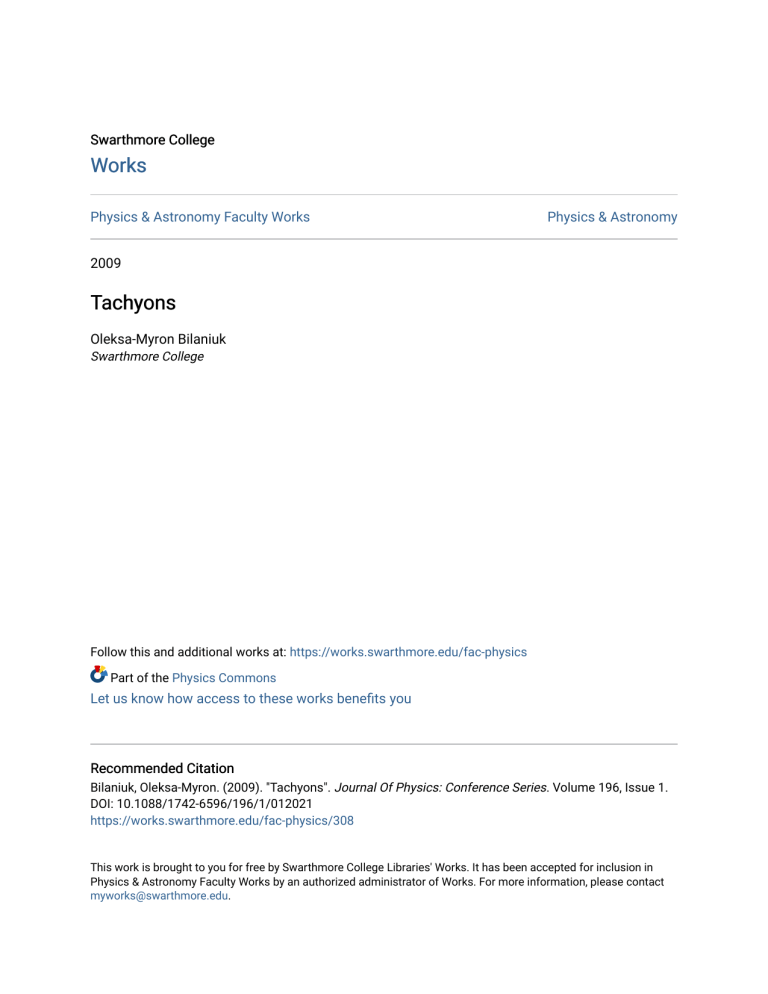
Swarthmore College Works Physics & Astronomy Faculty Works Physics & Astronomy 2009 Tachyons Oleksa-Myron Bilaniuk Swarthmore College Follow this and additional works at: https://works.swarthmore.edu/fac-physics Part of the Physics Commons Let us know how access to these works benefits you Recommended Citation Bilaniuk, Oleksa-Myron. (2009). "Tachyons". Journal Of Physics: Conference Series. Volume 196, Issue 1. DOI: 10.1088/1742-6596/196/1/012021 https://works.swarthmore.edu/fac-physics/308 This work is brought to you for free by Swarthmore College Libraries' Works. It has been accepted for inclusion in Physics & Astronomy Faculty Works by an authorized administrator of Works. For more information, please contact myworks@swarthmore.edu. Journal of Physics: Conference Series Related content Tachyons - Introduction to "Tachyons": The sixth quest David Freedman To cite this article: Oleksa-Myron Bilaniuk 2009 J. Phys.: Conf. Ser. 196 012021 - ON VARIABLE 39 IN IC 1613 J. L. Hutchinson - IN 1903 Harold D. Babcock View the article online for updates and enhancements. Recent citations - Calculation of the decay rate of tachyonic neutrinos against charged-lepton-pair and neutrino-pair Cerenkov radiation Ulrich D Jentschura et al - Neutrino helicity reversal and fundamental symmetries U D Jentschura and B J Wundt - Tachyonic field theory and neutrino mass running Ulrich D. Jentschura This content was downloaded from IP address 130.58.65.11 on 10/11/2017 at 18:20 Sudarshan: Seven Science Quests Journal of Physics: Conference Series 196 (2009) 012021 IOP Publishing doi:10.1088/1742-6596/196/1/012021 Tachyons Oleksa-Myron Bilaniuk Swarthmore College, Pennsylvania Email: obilani1@swarthmore.edu Let me begin by expressing my wholehearted admiration for the extraordinary genius and the wonderful personality of George Sudarshn. It was not only a great privilege but also a genuine pleasure working with him on the tachyon problem during our Rochester days. Before the publication by Albert Einstein of his paper “Zur Electrodynamik bewegter Korper” (“On the Electrodynamics of Moving Bodies”) in June 1905 [1], physicists had no reason to restrict their consideration of motions to velocities limited by that of light in vacuum. Some of such publications are listed in references [2-8]. One of the preeminent physicists who wrote extensively on electrons “moving in any given way” was Arnold Sommerfeld [5]. All such speculation came to an abrupt halt in 1905, after Einstein’s publication of June 1905, where he explicitly stated: “…speeds in excess of light have no possibility of existence…”. The main reasons for the v > c restriction are: • Even with infinite amount of energy v cannot exceed c : v < c . • With m = mo(1 – v2/c2)-1/2 and a real, positive m, v > c implies an “unphysical” imaginary proper mass mo. • Causality violation : travel into the past would become possible. The concept of an imaginary proper mass was dismissed offhand as “unphysical”. The need for an infinite amount of energy to accelerate a mass close to the velocity of light, the requirement for the mass traveling at v > c to have an “unphysical” imaginary value, and the apparent possibility of traveling into the past at v > c -- these three conundrums had a chilling effect on anybody who was impudent enough to take seriously the possibility of a particle moving faster than light in vacuum. The causality violation by anything purportedly traveling backward in time was evocatively described in 1930 by Reginald Buller in his limerick: There was a young lady named Bright Who traveled far faster than light. She went out one day In a relative way And returned the previous night. Worldwide, until 1962, trying to publish anything that seemingly contradicted Einstein automatically ran the risk of being considered a crank. An interesting 1963 Spanish version of the above limerick is attributed to “Traductor Anonimo”. In 1974, when George Sudarshan and I published “Beyond the Light Barrier ” in Russian in “Einsteinovskyi Sbornik 1973” (“Einstein Collection”), Acad.Sci.USSR, Moscow, 1974, we found an imaginative Russian version by a well-known poet S. Ya. Marshak. 1 Sudarshan: Seven Science Quests Journal of Physics: Conference Series 196 (2009) 012021 IOP Publishing doi:10.1088/1742-6596/196/1/012021 To get the first paper on tachyons by George Sudarshen, his student V.K. Deshpande, and myself published – we had to resort to some diplomatic maneuvering. At a meeting of the American Physical Society in 1961, I spotted Walter Michels, the editor of the American Journal of Physics, chatting with the chairman of the Rochester Physics Department, Robert Marshak. I managed to join their conversation and found an opportunity to ask Bob Marshak to assure professor Michels that George Sudarshan and Oleksa Bilaniuk were respectable, bona fide physicists. Moreover, Bob Marshak asked Michels to examine our prospective submission on “Metarelativity” thoroughly and seriously, and not throw it automatically into the waste basket, which on first sight might appear the normal thing to do. As a result, our publication appeared in record time. Our paper rapidly became widely quoted and a number of intrepid experimentalists started looking for faster-than-light particles, particularly after Gerald Feinberg published, in 1967, an attempt at quantization of our “metaparticles”, which he aptly renamed tachyons (from Greek tacis=swift). But the acceptance was not universal. A challenge came, of all places, from the “dean” of science-fiction writers, Isaac Asimov, who published an article [12] on the subject, entitled “Impossible, that’s all.” Improbably, who came to our defense but another renowned science fiction writer, Arthur C. Clarke, with the article [13] “Possible, that’s all.” In the end, Isaac Asimov wrote a contrite article [14] “The Luxon Wall ”, in which he admitted that he had been “left flat-footed by the advance of physics.” He even called me and as a result he was invited to give a talk at Swarthmore. He was a sincere and deep-thinking person and we parted as best of friends. On a more serious note, over 600 publication on tachyons, experimental and theoretical, appeared in the first 18 years following our 1962 “Metarelativity” paper. Please see Ref. 15 for a full listing. A number of these dealt with the resolution of the causality problem, which remained vexing for a while. In the end, it became clear that tachyons do not lead to causality violation either in the framework of special or of general relativity [16,17]. As soon as it became evident that no laws of physics prohibit the existence of faster-than-light objects, experimentalists, as if mindful of Gell-Mann’s witty “Totalitarian Principle” [18], envisioned searches for the mystifying tachyons. Another jocular aphorism, the “Alvarez Criterion”, may be quoted to envision the considerations which the potential tachyon searchers must have before embarking on their experiments. The Alvarez criterion is stated in terms of : μ = P x where μ = merit of an experiment, P = probability of its success, and = significance of the result. For tachyons, P=0 and = infinity, so that μ = 0 x infinity, which is indeterminate. The outcome of tachyon experiments being indeterminate, the decision rested with the gumption of the experimenters. Considering the number of tachyon search experiments (see a partial list in Refs. 19-31), the gumption was indeed high. The searches included: 1. search for tachyonic magnetic monopoles, 2. tachyon Michelson experiment, 3. missing mass searches in bubble chamber and emulsion records. There were over 300 papers during 1967-1980 on the quantum mechanics of tachyons. For a full bibliography, please see Ref. 15. Indications that electron neutrinos may be tachyonic was published in 1985, by Alan Chodos, Avi I. Hauser and V. Alan Kostelecky in 1985 [22], and other papers exploring this hypothesis, have re-energized both the experimental and theoretical interest in tachyons. Preliminary results of measurements of the endpoint of the electron energy spectrum of tritium decay yield negative values of (neutrino mass)2 = -27 + 20 eV . This would indicate that the proper mass of the neutrino is imaginary and that the neutrino is in fact a tachyon. Experimenters now face the challenge to obtain a result which would prove beyond any doubt that the mass of 2 Sudarshan: Seven Science Quests Journal of Physics: Conference Series 196 (2009) 012021 IOP Publishing doi:10.1088/1742-6596/196/1/012021 the electron neutrino is indeed imaginary. A summary of experimental results for (neutrino mass)2, obtained in 1991 – 2000 is given in the following table: EXPERIMENT MEASURED M2 FORMAL LIMIT C.L. % YEAR Mainz -1.6 ± 2.5 ± 2.1 eV2 2.2 95 2000 Troitsk -1.0 ± 3.0 ± 2.1 eV2 2.5 95 2000 Zurich -24 ± 48 ± 61 eV2 11.7 95 1992 Tokyo INS -65 ± 85 ± 65 eV2 13.1 95 1991 Los Alamos -147 ± 68 ± 41 eV2 9.3 95 1991 Livermore -130 ± 20 ± 15 eV2 7.0 95 1995 China -31 ± 75 ± 48 eV2 12.4 95 1995 Avegare of PDG (98) -27 ± 20 eV2 15.0 95 1998 Another approach to ascertain if electron neutrinos are tachyons involves verifying if the “knee” in the cosmic ray spectrum is due to high-energy proton decay p -> n + e+ + , with concomitant emergence of a neutron spike where would have negative energy in proton’s rest frame, hence would be tachyonic. The possibility of the “knee” being due to such “tachyonic” proton decay has been discussed in a number of papers, including Ref. [31]. The examination of the relativistic velocity addition v = (u + v) (1 + uw/c2) -1/2 involving superluminal velocities leads to a curious conclusion. If there is a parallel tachyonic universe, all velocities within that universe would be seen by us as greater than c, but would be seen as less than c by the inhabitants of that universe. Conversely, to the inhabitants of that universe, all velocities within our world would appear to be tachyonic. Tachyons have so far eluded physicists, but not enterprising vendors. There is a number of “tachyonized” products on sale and books that provide guidance how to stay healthy by using tachyons [32-33]. Astrologers too seem to have a keen interest in tachyons. In their Australian journal Alternate Universe they have published an article “Tachyon Universe Discovered”. But in contrast to the tachyon vendors, they give a clue that this discovery should not be taken too seriously: The date of the publication is April 1, 2006. References [1] Einstein A 1905 Zur Electrodynamik bewegter Korper (On the Electrodynamics of Moving Bodies), Ann. Phys. 17, 891 [2] Thomson J J 1889 Phil. Mag., 23, 13 [3] Heaviside O1892 Electr. Papers, VII, Chap.47, 497, MacMillan & Co., London [4] Des Courdes TH., Arch. Neerland. Sci., II S, 652, 1900. [5] Sommerfeld A 1904 Simplified deduction of the field and the forces of an electron moving in any given way, Knkl. Acad. Wetensch, 7, 345-367 [6] Sommerfeld A 1904 K. Akad. Wet., Amsterdam, Proc. 8, 346 [7] Sommerfeld A 1904 Nachr. Ges. Wiss. Gottingen, 99, 363 [8] Sommerfeld A 1904 Proc. Amst. Acad. 26, 357 [9] Sommerfeld A 1905 Nachr. Ges. Wiss. Gottingen, 201-235 [10] Sudarshan E C G and Bilaniuk O M 1974 Beyond the Light Barrier in Einsteinovskyi Sbornik 1973 (Einstein Collection), Acad. Sci. USSR, Moscow [11] Bilaniuk O M, Deshpande V K and Sudarshan E C G 1962 Metarelativity, Am. J. Phys. 30, 718-723 3 Sudarshan: Seven Science Quests Journal of Physics: Conference Series 196 (2009) 012021 IOP Publishing doi:10.1088/1742-6596/196/1/012021 [12] Isaac Asimov: Impossible, that’s all in Magazine of Fantasy and Science Fiction, December 1967, p.113. [13] Arthur C Clarke: Possible, that’s all in Magazine of Fantasy and Science Fiction, October 1968 [14] Isaac Asimov: The luxon wall in Magazine of Fantasy and Science Fiction, December 1969, p.96. “…suddenly I sounded like a fuddy-duddy left flat-footed by the advance of physics…” [15] Perepelitsa V P 1980 Full bibliography on faster-than-light particles, Institute of Theoretical and Experimental Physics, ITEP-100 & 165,Moscow [16] Bilaniuk O M and Sudarshan E C G 1969 Causality and spacelike signals. Nature, 223, 386-387, 1969 and Physics Today 22/12, 50-52 [17] Perepelitsa V F 1981 Principle of causality, relativity theory and superluminal signals, Institute of Theoretical and Experimental Physics, Moscow, ITEP 104 [18] Gell-Mann’s Totalitarian Principle: Anything which is not prohibited is compulsory. (After White T H) [19] Alvager T, Blomquist J, Erman P 1963 Ann. Rep. of Nobel Res. Inst., Stockholm, p.95-97 [20] Alvager T, Erman P, Kerek A 1965 Ann. Rep. Of Nobel Res. Inst., Stockholm [21] Alvager T, Kreisler M N 1968 Quest for faster-than-light particles, Phys. Rev. 171, p. 1357-1361 [22] Davis M B, Kreisler M N, and Alvager T 1969 Search for faster-than-light particles Phys. Rev. 183, p. 1132-1133 [23] Bartlett D F, Lahana M D 1972 Search for tachyon monolpoles, Phys. Rev. D6, p.18171823 [24] Baltay C, Feinberg G 1970 N. Yeh, R. Linsker, Search for uncharged faster-than-light particles, Phys. Rev. D1, p.759-770 [25] Danburg J S, Kalbfleish G R, Borenstein S R, Strand R C, Vanderburg V, and Chapman J W 1971 J. Lys, Search for ionizing tachyon pairs from 2.2 GeV/c K-p interactions, Phys. Rev. D4, p.53-65 [26] Clay R W and Crouch P C 1974 Possible observation of tachyons associated with extensive air showers, Nature 248, p. 28-30 [27] Bartlett D F, Soo D, and White M G 1978 Search for tachyon monopoles in cosmic rays, Phys. Rev. D18, p. 2253-2261 [28] Bhat P N, Gopalkrishnan N V, Gupta S K, and Tonwar S C 1979 Search for tachyons in EAS, J. Phys. G5, p. L13-L18 [29] Chodos A, Hauser A I, and Kostelecky V A 1985 Neutrino as a Tachyon, Phys. Lett., 150B/6 [30] Ciborowski J and Rembielinski J 1999 Tritium decay and the hypothesis of tachyonic neutrinos, Eur. Phys. J C8, 157-161 [31] Robert Ehrlich 2000 Neutrino mass2 inferred from the cosmic ray spectrum and tritium beta decay, Phys. Rev. D 60, 229-232 [32] Martina Bochnik & Tommy Thomsen 2005 Holistic Wellness with Tachyons: A practical guide to the use of Tachyons 224 pages [33] David Wagner and Gabriel Cousens 2000 Tachyon Energy: A New Paradigm in Holistic Healing, MD, North Atlantic Books 4
